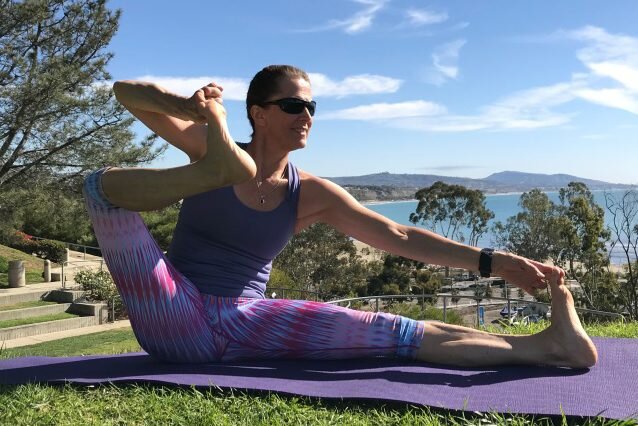Akarna Dhanurasana
A = towards
Karna = ear
Danurasana = bow
Akarna Dhanurasana literally means "Toward-the-Ear Bow Pose," but is better described as "Archer Pose," since it resembles an archer preparing to release her arrow.
In his book, “Light on Life,” Mr. Iyengar states that, “The body is the bow, asana is the arrow and the soul is the target.”
Your practice leading to Akarna Dhanurasana can be a way of discovering how you use your body and mind to aim towards your target. Is your aim the posture itself? Or, are you interested in going deeper and learning more about yourself?
As with any advanced posture, it is important to pay attention to the quality of your breath and your state of mind as you work through the poses that lead to the final shape.
Here is a sequence of poses to help you on the road to Archer’s Pose and your own inner awareness.
Seated Crossed Leg Posture
This posture is sometimes called Easy Pose. It is the first hip opening seated pose most student encounter. Sit with your shins crossed and your feet under your knees. The pinky toe edges of your feet are on the floor with the soles of your feet facing sideways. Sit for several breaths with your right leg crossed in front and then switch legs. Soften your tongue, jaw and eyes as you settle in and notice if there is any physical resistance.
Goddess
Stand with your feet wide and your toes slightly turned out, knees and toes pointing in the same direction. Pulse up and down a few times and then hold the posture for five breaths. Lengthen from your pubic bone out towards your inner knees and contract from your outer knees into your outer hips as you work your hips open.
Warrior II
The asymmetry of Warrior II makes the hip opening a little more challenging and a little more like the asymmetry of Archer’s Pose. As you deepen the bend in your front knee towards 90 degrees, pay attention to the alignment of your outer front hip and the outer edge of your front foot keeping these two points in line. In every yoga pose we are looking for the symmetry of Tadasana. Find length in your spine and stay erect without leaning towards the front leg. This same lifting action is as important here as it is in the final pose.
Squat
If the heels do not reach the floor, you can prop the heels, but I prefer holding a weight in the hands. This counterbalances your weight and stretches your calves and quads more. Squatting uses gravity to open the hips. Start by keeping your torso more upright, especially if your heels don't touch the ground, but once that happens you can work on reaching forward.
Cobbler
Look for the same opening of the inner thighs as in Goddess and the same lift in the spine as in Warrior II. In the final position of Cobbler’s Pose, the knees are on the ground. Be patient if your knees are higher than that. You may sit on a blanket to raise your hips, lowering the knees by relativity. The hips will be more inclined to open if the pelvis is upright rather than tipping backwards.
Seated Tree
Like Warrior II and Goddess Pose, Janu Sirsasana is more challenging because again it introduces the element of asymmetry. In this version, it is not important to fold forward but rather to work on staying upright and finding the lift of the chest. Work on the opening of the hip that takes the bent knee out to the side.
Maricyasana I
Lifting the knee in Maricyasana I introduces the element of moving the torso forward inside the bent leg.
Happy Baby and Variations
These variations use gravity to bring the knees toward the floor, the same direction the bent knee moves in the upright version. While lying on the floor you get the immediate feedback of how rounded your spine may be. Work the spine long, bringing more of your sacrum to the floor.
Archer’s Pose prep
This version allows you to feel how to lift the leg and pull the foot towards your ear, rather than moving your ear towards your foot, keeping the spine lifted.
Archer’s Pose
This final version of the pose is dependent on the previous stages. If all of those pieces fall into place then it is possible to draw the leg back with the breath and sit up straight and tall.
Notice where you start to lose the breath and equanimity of mind and go back to those stages; be content with exploring those poses. Work with patience, humility and curiosity as you continue the journey to self discovery.


